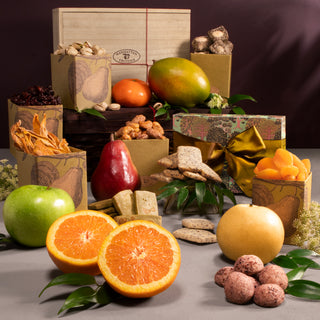Purim is one of those holidays that dances onto the Jewish calendar with joy, laughter, and a touch of whimsy. Celebrated on the 14th of Adar (which typically falls in March), Purim isn’t just a religious observance—it’s a festive celebration of survival, identity, and the triumph of good over evil. And, as with many joyous occasions, Purim holiday traditions are filled with gift giving, vibrant costumes, and, of course, plenty of food. In 2025, it begins the evening of March 13th, through Friday, March 14th—on the fourteenth day of the month of Adar.
The History of Purim
The history of Purim is based on the Book of Esther (Megillat Esther), which tells the tale of the Jewish people’s salvation in ancient Persia. The villain of the story is Haman, the royal advisor to King Ahasuerus, who plots to annihilate the Jews. Enter Esther, the courageous Jewish queen who, with the help of her cousin Mordecai, bravely risks her life to expose Haman’s wicked plans and save her people. The king, who had been unknowingly manipulated by Haman, turns the tables on him, leading to Haman’s downfall and the victory of the Jewish people.
The holiday’s name, “Purim,” comes from the Persian word “pur”—meaning “lot,” referring to the lottery that Haman used to select the date for his planned destruction of the Jews. Instead of being a day of doom, the lottery resulted in a joyous occasion for the Jewish people.
Celebrating Purim Holiday Traditions and Customs
1. Mishloach Manot (Gift Giving)
Purim is a time for sharing, and one of the most charming Purim holiday traditions is the exchange of mishloach manot, or literally translated, “sending of portions” or in other words, gift baskets. These baskets typically contain at least two different types of food that are ready to eat, symbolizing the importance of nourishing friends and family. Traditionally, these gifts include hamantaschen, triangular pastries filled with sweet fillings like poppy seeds, fruit preserves, or chocolate—such as are featured in the Halva Some Hamantaschen Gift Hamper, a delicious hamantaschen sampler featuring two unique treats for two unique blessings. It’s a beautiful way to spread joy, love, and community spirit.
2. Costumes and Festive Dress
Queen Esther’s courage and hidden Jewish identity are central to the history of Purim, and so wearing costumes on Purim serves as a playful reminder that things are not always as they seem. People of all ages dress up in costumes ranging from simple to extravagant—it’s a day to let your creativity shine. It is why Manhattan Fruitier designed its Purim kosher cookies in the shapes of bejeweled masks and crowns!
3. The Megillah (Reading the Scroll)
One of the most beloved Purim holiday traditions is the reading of the Megillat Esther, the Scroll of Esther. This story is read aloud in synagogues, and the atmosphere is far from somber—it's filled with noise, excitement, and even some playful chaos. Every time Haman’s name is mentioned, the crowd drowns it out with loud boos, rattles, and groggers (noisemakers). It’s a wonderful, participatory experience that reminds everyone of how sweet it is to see good triumph over evil. The word ‘tash’ in Hebrew means ‘weaken’—it may be that eating hamantaschen or ‘weakening Haman’ symbolizes the many incidents described in the Megillah where the tables are turned on the evil Haman, or even showing how something bad and evil can be turned into something sweet. A wonderful way to invite everyone to participate, Manhattan Fruitier’s The Whole Megillah Purim Gift Basket includes kosher Purim Cookies, Halva, a Hamantaschen tin, and even a Jewish Wisdom Ball to keep the fun going.
4. Seudat Purim (The Purim Feast)
No holiday is complete without a good meal, and Purim is no exception. The seudat Purim is a festive meal that often includes foods such as kreplach (dumplings), fresh fruit, roasted meat, and sweet desserts, such as Babka, and kosher chocolate toffees. But the highlight, as previously noted, is the hamantaschen. The reason? In Yiddish, the word hamantaschen is literally translated as ‘Haman’s hat’, ‘Haman’s pocket’, or even ‘Haman’s ears’! The triangular shape of the pastry is a representative visual reminder of the triumph over the evil Haman. Manhattan Fruitier’s Purim holiday tradition gift, the Purim Surprise, which includes ready-to-eat (another Purim holiday tradition) rich chocolate Babka, kosher Purim cookies, and of course, hamantaschen, is an easy way to make any Purim feast memorable.
5. Matanot La'evyonim (Charity)
Purim is also a time for giving to those in need. Matanot la’evyonim refers to the tradition of giving charity to the poor, ensuring that everyone can partake in the joy of the holiday. It is a time when generosity is the byword, and one of the best of Purim holiday traditions.
What makes the Purim holiday so special is its combination of joy and meaning. It’s a reminder that even in the face of adversity, the Jewish people have always persevered, with humor and strength. The hidden messages of the Purim holiday—of bravery, resilience, and the power of community—resonate with us all, no matter our background or beliefs.
Looking for celebration-ready Purim gifts?
Shop our Purim Gifts Collection!




